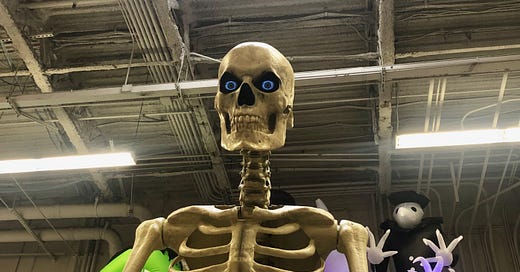
Pandemic Life: We Are All Skeletons Now
In 2020, nothing feels truer than a massive, expensive, decorative representation of our own mortality.
A few weeks ago, a towering skeleton briefly consumed our collective consciousness. Officially called the 12 ft. Giant-Sized Skeleton with LifeEyes and colloquially known as The 12-Foot Home Depot Skeleton, the $300 display was met with feverish reviews, touted as highly coveted, and was written about by pretty much every outlet imaginable. It quickly sold out and was resold online for ungodly amounts, successfully saturated the meme market, and was heralded as a metaphor for our grisly times—all within a few days.
During that week, if you had cracked open the skull of the internet, it would have looked like this:

The skeleton was us, and we needed to possess it at all costs. Now, who knows where the hell all these people will store their prized plastic bones when Halloween is over.
Elsewhere, small children have become infatuated with skeletons of their own. In Salt Lake City, a toddler named Theo has become hopelessly attached to a 5-foot-tall decorative skeleton he calls Benny. A 3-year-old in LA also has a skeleton bestie. My own 8-year-old nephew has long nursed an affinity for skeletons, as well as zombies, as well as actual human tragedies like the Titanic, and those chronicled in the ‘I Survived’ book series.
Here he is as a 3-year-old. A boy after my own heart....
And oddly enough, there’s another oversized skeleton in the news this week: a real one, belonging to a man once known as Charles Byrne. Byrne was an 8’4’’ Irishman who suffered from acromegalic gigantism and died in 1783. Worried that his skeleton would be coveted after he died, Byrne had asked his friends to bury him at sea in a lead coffin, but his plans were thwarted, and his remains were ultimately put on display. In recent years, many have called for his body to finally be put at rest as the man himself requested. Author Hilary Mantel, who wrote a fictionalized book about Byrne, recently told The Guardian, “I think that science has learned all it can from the bones, and the honourable thing now is lay him to rest. It would suit the spirit of the times, and I don’t see a reason for delay. He’s waited long enough.”
While October is certainly the prime season for skeleton news, broader human fixation on skeletons is nothing new. We’ve been fascinated with our own framework, our inner armor, since at least the Middle Ages (and let’s be honest, probably before), and 16th-century cabinets of curiosity often included human skulls. We’ve long used art and decoration as a means of not just coping with, but fully embracing, death, and there’s no better focal point for the externalization of our inner turmoil than the skeleton. The Danse Macabre or Dance of Death is a genre unto itself, and encapsulates why the skeleton is such an ever-present character. It’s funny, disquieting, and ultimately unifying.
It doesn’t matter who you were in life, how you treated people, what you wore, or how you died. The big sleep is coming for us all, and what’s left at the end is bones. Skeletons are a perfect combination: a pure distillation of death and something goofy enough to feel separate from reality. They’re the grim truth and an utter farce. How could we not be obsessed?
And while humans have been preoccupied by skeletons and death since time immemorial, something about the leadup to Halloween 2020 feels pointedly different.
It’s not just that we appear to be willing to sell a kidney to procure an absurdly large and expensive decoration to put in the lawn. It’s not just that children who are barely old enough to register the concept of death are linking arms with child-size skeletons. No, it’s the less fantastical stories that feel eeriest. Everywhere you look, people are contorting skeletons so that we might watch them roleplay the lives we are currently living. They’re on Zoom calls, watching presidential debates (when I die PLEASE get me as far away from a presidential debate as possible), camping and literally fighting off coronavirus. They’re not meant to be profound statements, but it’s hard not to look at a skeleton working from home and feel like you’re seeing more than a Halloween decoration.
The added solemnity isn’t just because we’re so fully surrounded by death this year. Yes, we’re all more aware than ever of our own mortality and the fragility of life, more stressed than ever over an increasingly apocalyptic world, and more anxious about how to avoid killing ourselves and others (writing that just now made me remember all over again that we’re actually living through a pandemic). All of that is true, but many of us are also simply far more aware of our own bodies than we’ve ever been before.
From day one of the pandemic, everyone—by necessity—became obsessed with the very immediate and tangible functions of our own bodies. We’ve obsessed over what we consume and how we consume it, obsessed over exercise, obsessed over sleep, obsessed over the smallest changes in our breathing or temperature that could mean something dire, obsessed over testing our bodies, obsessed over dressing them, obsessed over making them hot or not, obsessed over hair, obsessed over the crushing absence of what it feels like to touch another body, obsessed over how to be around other bodies safely. And yes, obsessed over our own bones. Skeleton obsession is really just self-obsession, and we’re all quite good at that.
Never have I been more aware of my own corporeal form—for better and for worse. In isolation, I swing back and forth between extreme disquiet and total disengagement. One minute I’m agonizing over whether I should eat more vegetables and less pasta, and the next I’m looking at coronavirus graphs for every county in California and chugging a beer. I look at the same online stores at items I’ll never buy and put them in a virtual cart. At the end of the day, I close those tabs and fall asleep speculating about the manner in which I’ll eventually shuffle off this mortal coil and how babies are born with 300 bones but adults only have 206 and how my dad kept all our teeth for the tooth fairy in a wooden box on his dresser.
We’ve spent over seven months now being seen and unseen. Staring at ourselves on Zoom calls, in the mirror, and in window reflections while we wait in grocery store lines. With masks and sunglasses on, we lose some sense of identity. We could be anyone. We might as well be skeletons.
Last week, in an interview about the 12 Foot Home Depot Skeleton, the company’s merchant for decorative holiday items told Slate: “We’re always trying to do something bigger and better every year, so it’s going to be a challenge to top this one next year.”
This stuck with me days after I read the interview. What’s the strategy for outdoing a truly enormous figure of death incarnate? How do you top a year of so many extremes? And do we really want to?
Weeks before I even knew the phrase 12 Foot Home Depot Skeleton, I actually encountered the legend myself. (Here’s where I must note that the 12 Foot Home Depot Skeleton is actually funny cancelled because Home Depot is a bad company that does not treat workers well and was co-founded by a bad billionaire. Alas, I had a home improvement emergency and my local shop isn’t open on Sundays.) I gazed up at the ominous figure, looked into its eyes, and thought briefly about how we are all bags of bones in a meat pouch. I realized at that moment that it was the eyes—obviously not a normal feature of skeletons—that made the decoration so enchanting. This skeleton isn’t like any other. In a year of abstraction, unknowns, and perpetual fear, there’s something alluring about a figure of death that, when you look him straight in the eye, looks right back.













